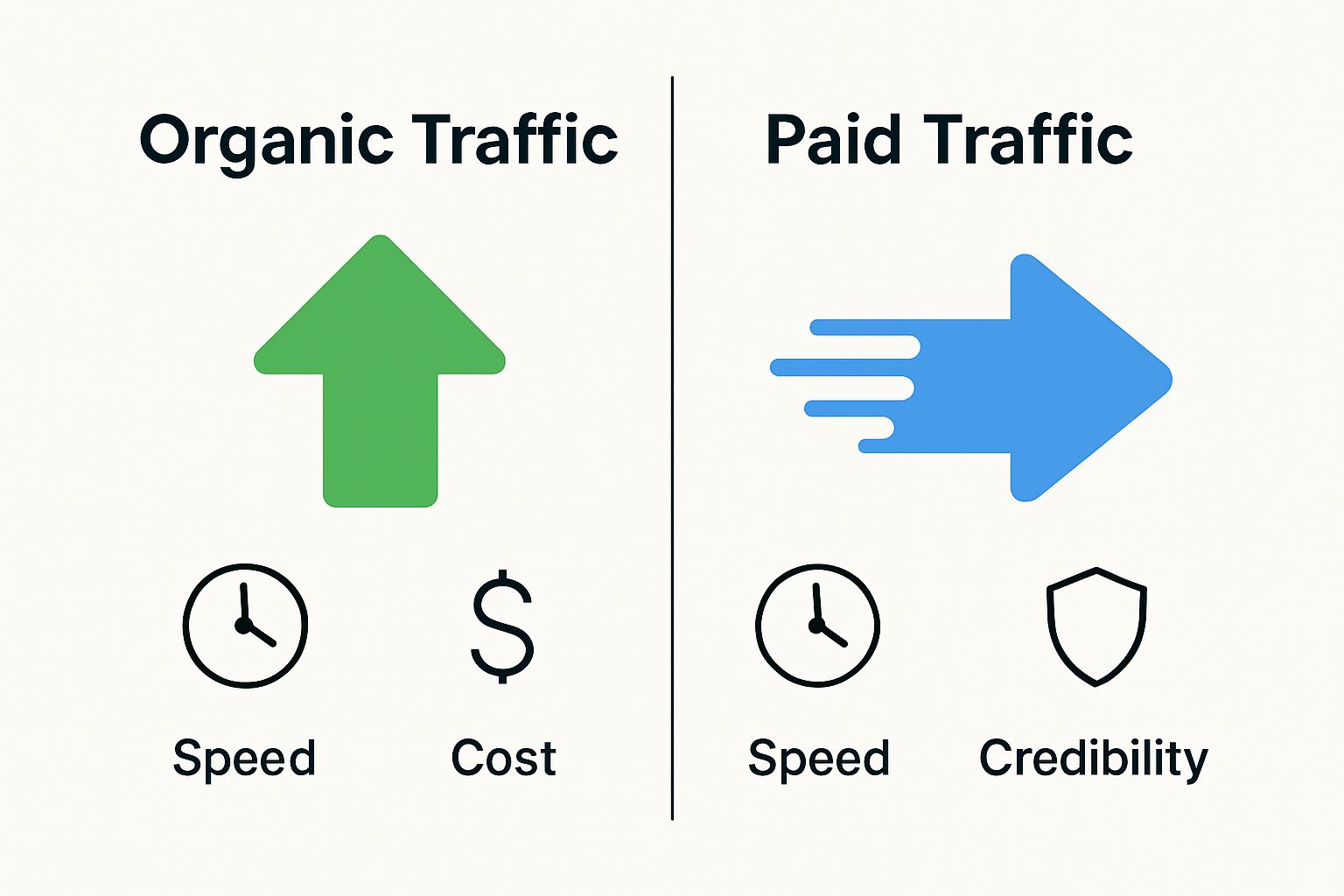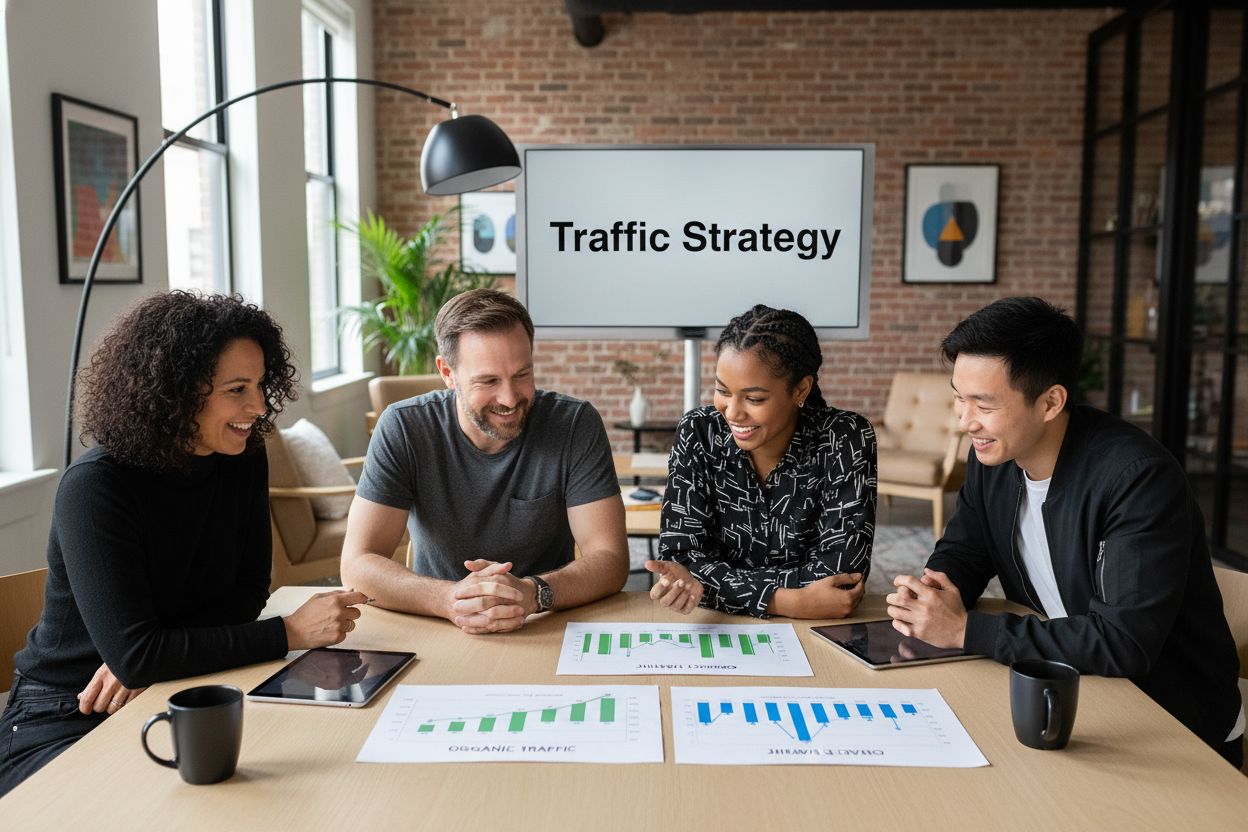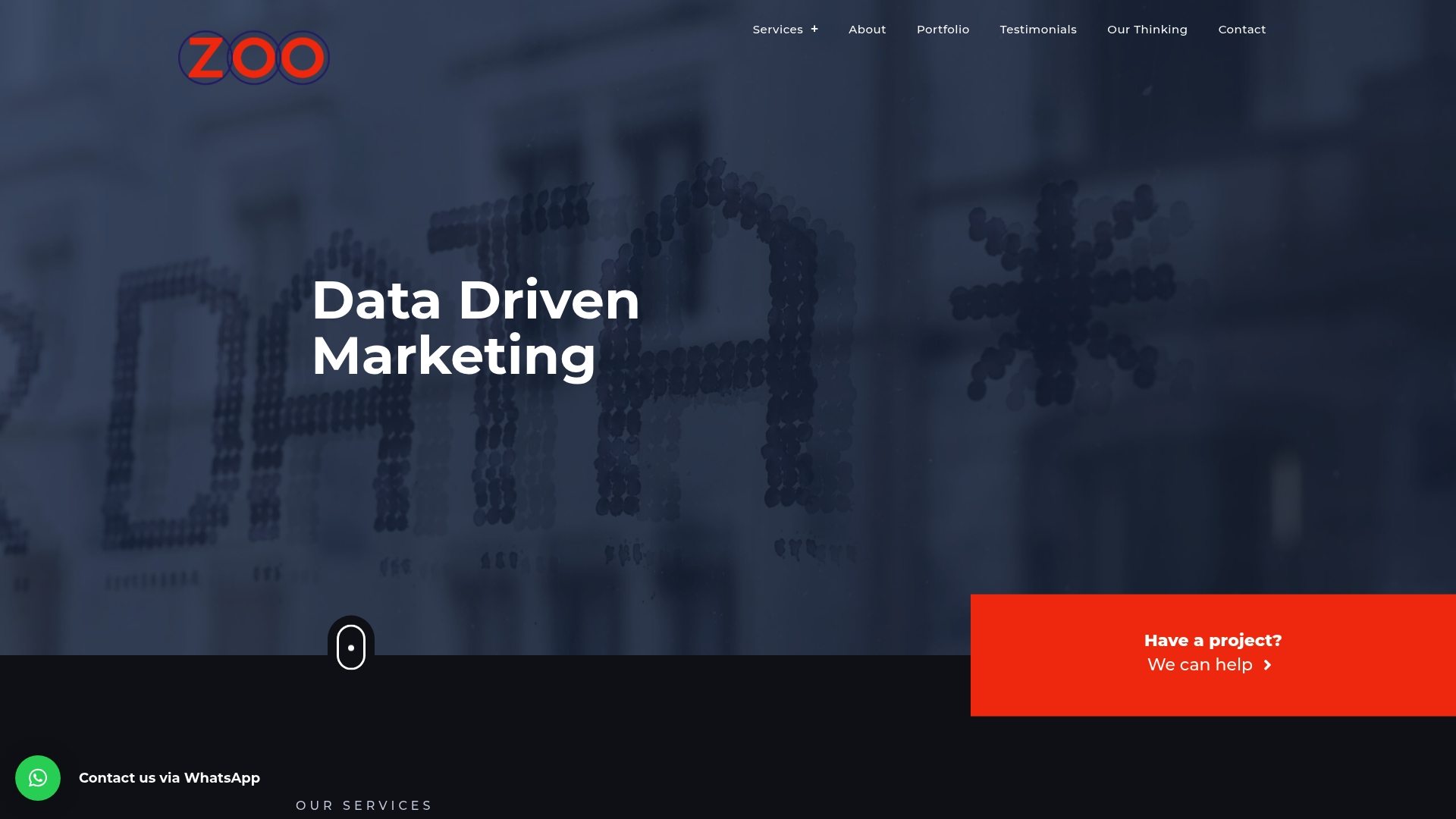Most businesses focus all their energy on attracting more people to their websites. But here is something most miss. Over 53 percent of all web traffic comes from organic search, while paid ads account for only about 15 percent. You would think paid ads win because of the spend, but organic visitors stick around longer and trust you more. That flips the usual logic right on its head and gets you rethinking what really pays off online.
Table of Contents
- Defining Organic And Paid Traffic In Digital Marketing
- The Importance Of Organic Vs Paid Traffic For Businesses
- How Organic And Paid Traffic Impact Online Visibility
- Evaluating The Cost-Effectiveness Of Organic Vs Paid Traffic
- Real-World Examples Of Organic And Paid Traffic Strategies
Quick Summary
| Takeaway | Explanation |
|---|---|
| Organic traffic builds long-term credibility. | Investing in organic traffic fosters trust and authority with users over time, leading to sustainable growth. |
| Paid traffic offers immediate visibility. | Businesses can quickly reach specific target demographics through paid ads, ensuring instant exposure to potential customers. |
| Balance organic and paid strategies. | Combining both traffic types maximizes outreach, leveraging immediate engagement and ongoing credibility effectively. |
| Consistent content investment is key. | Ongoing commitment to high-quality content contributes to organic traffic success while enhancing search engine rankings. |
| Monitor costs in paid advertising. | Understanding budget management and tracking performance is essential for optimizing paid traffic investments efficiently. |
Defining Organic and Paid Traffic in Digital Marketing
In the complex world of digital marketing, understanding how traffic flows to your website is crucial. Organic and paid traffic represent two fundamental pathways through which potential customers discover and interact with your online presence. These approaches differ significantly in their strategy, cost, and long-term effectiveness.
Below is a comparison table outlining the key differences between organic and paid traffic in digital marketing to help clarify their distinct characteristics and benefits.
| Aspect | Organic Traffic | Paid Traffic |
|---|---|---|
| Acquisition Method | Earned through SEO and content efforts | Purchased via online advertising platforms |
| Cost Structure | No direct cost per visitor, but time & effort | Direct, ongoing financial investment required |
| Speed of Results | Takes time to build and grow | Provides immediate visibility |
| User Perception | Viewed as more credible and trustworthy | May be seen as less trustworthy (labelled as “Ad”) |
| Long-Term Value | Sustainable and compounding returns | Results stop when ad spend stops |
| Audience Targeting | Broad, less precise targeting | Highly targeted by demographics, behaviour, etc. |
| Primary Role | Builds authority and trust over time | Drives instant traffic and quick feedback |
What is Organic Traffic?
Organic traffic refers to visitors who arrive at your website through unpaid search engine results. When someone searches a query and clicks on your non-sponsored link in search rankings, that’s organic traffic. Search Engine Journal explains this occurs through strategic search engine optimisation (SEO) techniques like creating high-quality content, using relevant keywords, and building authoritative backlinks.
Key characteristics of organic traffic include:
- Free and sustainable visitor acquisition
- Higher user trust and credibility
- Long-term growth potential
- Requires consistent content and SEO investment
Understanding Paid Traffic
Paid traffic represents visitors generated through direct advertising investments. Businesses pay platforms like Google Ads or social media networks to display targeted advertisements that drive potential customers to their websites. These ads appear distinctly from organic search results, often marked with a small “Ad” label.
With digital marketing budget allocation becoming increasingly strategic, businesses must understand paid traffic’s nuanced approach. Paid traffic offers immediate visibility and precise audience targeting, allowing companies to reach specific demographics quickly.
The primary advantage of paid traffic is its ability to generate immediate results, enabling businesses to test marketing messages, track precise performance metrics, and adjust strategies in real-time. However, it requires continuous financial investment to maintain visibility.
The Importance of Organic vs Paid Traffic for Businesses
Business success in the digital landscape hinges on understanding and strategically leveraging organic and paid traffic. Both approaches offer unique advantages and play critical roles in comprehensive digital marketing strategies.
Strategic Business Growth Through Traffic Channels
Organically generated traffic represents a sustainable and cost-effective approach to business growth. Unlike paid traffic, organic strategies build long-term credibility and trust with potential customers. Marketing Analytics research demonstrates that businesses investing consistently in organic traffic development see more stable and predictable growth patterns.
Key advantages of prioritizing organic traffic include:
- Lower customer acquisition costs
- Higher quality website visitors
- Enhanced brand authority and reputation
- Sustainable growth independent of advertising budgets
Balancing Immediate Results with Long-Term Strategy
Paid traffic serves as a powerful complement to organic strategies, offering businesses immediate visibility and precise audience targeting. While organic traffic builds foundational credibility, paid traffic allows companies to quickly test marketing messages, reach specific demographics, and generate instant engagement.
Businesses must view organic and paid traffic as interconnected strategies rather than competing approaches. Smart digital marketing involves creating a balanced approach that leverages the strengths of both channels. How to Start Online Advertising provides insights into effectively integrating these traffic generation methods.
The most successful digital marketing strategies recognize that organic and paid traffic are not mutually exclusive. They are complementary tools that, when used strategically, can significantly amplify a business’s online presence and growth potential. By understanding the unique benefits of each approach, businesses can develop a nuanced, multi-dimensional digital marketing strategy that drives sustainable growth and maximizes return on investment.
How Organic and Paid Traffic Impact Online Visibility
Online visibility is the cornerstone of digital marketing success, and both organic and paid traffic play pivotal roles in determining a website’s digital presence. Understanding how these traffic channels influence search engine rankings, user engagement, and brand perception is crucial for businesses seeking comprehensive digital marketing strategies.
Search Engine Rankings and Credibility
Search engines like Google evaluate websites based on complex algorithms that consider organic performance. Organic traffic signals demonstrate a website’s relevance, authority, and user value. 7 Essential Tips to Increase Website Traffic highlights how consistent, high-quality content and strategic SEO practices directly impact search engine visibility.
Key factors influencing organic search rankings include:
- Quality and relevance of website content
- Number and quality of backlinks
- User engagement metrics
- Website loading speed and mobile responsiveness
Immediate Visibility vs Long-Term Credibility
Paid traffic offers businesses an immediate pathway to enhanced online visibility. Platforms like Google Ads and social media advertising enable precise audience targeting, allowing companies to appear prominently in search results and targeted feeds. This approach provides instant exposure, particularly beneficial for new websites or time-sensitive marketing campaigns.
However, paid visibility comes with distinct characteristics. While advertisements guarantee immediate placement, they are often perceived differently by users compared to organic search results. Users tend to view organic listings as more trustworthy and credible, understanding that these rankings are earned through content quality rather than direct payment.
The most effective digital marketing strategies integrate both organic and paid traffic approaches. By creating high-quality content that naturally attracts visitors and supplementing this with strategic paid advertising, businesses can maximize their online visibility, reach broader audiences, and build sustainable digital marketing ecosystems that drive consistent growth and engagement.
Evaluating the Cost-effectiveness of Organic vs Paid Traffic
Understanding the financial implications of digital marketing strategies is crucial for businesses seeking optimal return on investment.
 Cost-effectiveness becomes a critical consideration when comparing organic and paid traffic approaches, each presenting unique economic advantages and challenges.
Cost-effectiveness becomes a critical consideration when comparing organic and paid traffic approaches, each presenting unique economic advantages and challenges.
Initial Investment and Long-Term Value
WordStream reveals that organic traffic strategies require significant upfront investment in content creation, SEO optimization, and consistent digital marketing efforts. However, these investments generate sustainable returns over extended periods. Organic traffic develops a compounding effect where initial content continues generating website visitors without recurring advertising expenses.
Key cost considerations for organic traffic include:
- Minimal direct financial expenditure
- Substantial time investment in content creation
- Continuous skill development in SEO techniques
- Long-term brand credibility and authority building
Predictable Spending and Immediate Results
Paid traffic offers businesses precise financial control and immediate visibility. Companies can set specific budgets, target exact demographics, and track performance metrics in real-time. Digital advertising platforms enable granular spending control, allowing businesses to adjust investments based on campaign performance.
Businesses must recognize that while paid traffic provides quick results, it requires continuous financial commitment to maintain visibility. Each click represents a direct cost, making budget management and conversion optimization paramount. Digital Marketing Budget Allocation becomes essential in managing these financial dynamics.
The most strategic approach involves creating a balanced digital marketing ecosystem that leverages both organic and paid traffic. By understanding each method’s unique cost structures and potential returns, businesses can develop sophisticated marketing strategies that maximize financial efficiency and drive sustainable growth.
Here is a table summarising the main cost-related aspects of organic vs paid traffic, making it easier to weigh ongoing value and budget implications for your business.
| Cost Factor | Organic Traffic | Paid Traffic |
|---|---|---|
| Initial Investment | High (content, SEO, skill building) | Flexible (set by campaign budget) |
| Ongoing Costs | Low to none (mainly time for updating content) | Recurring (continues as long as ads run) |
| Return on Investment (ROI) Timeline | Long-term, cumulative | Immediate, but short-lived if spend stops |
| Budget Predictability | Difficult to quantify month-to-month | Highly predictable and controllable |
| Scalability | Grows steadily with effort | Scalable instantly, within available budget |
| Dependency | Less reliant on external spend | Fully dependent on continued ad spend |
Real-world Examples of Organic and Paid Traffic Strategies
Digital marketing success hinges on understanding and implementing strategic traffic generation techniques. By examining practical examples, businesses can gain insights into how organic and paid traffic strategies manifest in real-world scenarios.
Organic Content Marketing Approaches
Is it worth creating organic content? demonstrates that consistent, high-quality content remains a powerful organic traffic driver. Businesses can develop organic strategies through several key methodologies:
- Creating comprehensive blog posts addressing specific customer pain points
- Developing authoritative industry whitepapers and research guides
- Producing educational video content for YouTube and social platforms
- Implementing robust SEO strategies targeting specific keyword clusters
Targeted Paid Traffic Implementation
Paid traffic strategies offer businesses precise audience targeting and immediate visibility. Search Engine Journal highlights how businesses can leverage platforms like Google Ads, Facebook Ads, and LinkedIn Advertising to reach specific demographics with pinpoint accuracy.
Successful paid traffic campaigns often incorporate:
- Detailed audience segmentation based on demographics
- Compelling ad copy that speaks directly to user needs
- A/B testing different messaging and visual approaches
- Retargeting strategies to re-engage potential customers
The most sophisticated digital marketing approaches blend organic and paid strategies, creating a comprehensive ecosystem that maximizes visibility, engagement, and conversion potential. By understanding the nuanced strengths of each approach, businesses can develop multi-channel strategies that adapt to changing digital landscapes and customer behaviors.

Ready to Finally Grow Your Traffic and Convert More Clients?
Are you finding it tough to balance organic and paid strategies or not sure where your marketing spend is really going? Many businesses struggle to get meaningful results because it is difficult to connect the dots between SEO, advertising and data-driven decision making. The article highlighted how confusing it is to rely only on quick-win ads or slow-burning organic tactics. What most business owners want is clear growth and confidence they are investing in digital channels that work.

Zoo Digital focuses on making sure your digital marketing is seamless and effective. We combine expert web development and SEO services to increase your organic visibility. Our team are also specialists in Google Ads, Meta and TikTok advertising, giving your business instant visibility where it matters most. We also help you set up tracking and smart analytics so you can see exactly which strategy delivers results.
If you are serious about growing your traffic and want to connect every part of your digital marketing, now is the best time to act. Visit Zoo Digital today to set up a free strategy call. Let us show you how to turn insights into action and drive real growth for your business.
Frequently Asked Questions
What is organic traffic in digital marketing?
Organic traffic refers to visitors who arrive at your website through unpaid search engine results, primarily generated through effective search engine optimisation (SEO) techniques such as high-quality content creation and relevant keyword usage.
How does paid traffic differ from organic traffic?
Paid traffic involves visitors generated through direct advertising investments on platforms like Google Ads or social media. Unlike organic traffic, which is earned through SEO efforts, paid traffic provides immediate visibility but requires continuous financial investment.
What are the benefits of focusing on organic traffic?
Prioritizing organic traffic offers lower customer acquisition costs, higher quality website visitors, enhanced brand authority, and sustainable growth without relying on advertising budgets.
Can businesses effectively use both organic and paid traffic?
Yes, successful digital marketing strategies integrate both organic and paid traffic. While organic traffic builds long-term credibility, paid traffic allows for immediate visibility and targeted messaging, creating a balanced approach for optimal online presence.
Recommended
- How to Start Online Advertising: Guide for Small Businesses 2025 – Zoo Digital
- How to Use Marketing Analytics for Small Businesses in 2025 – Zoo Digital
- 7 Essential Tips to Increase Website Traffic – Zoo Digital
- Digital Marketing Budget Allocation: Smart Planning for 2025 – Zoo Digital
- Types of Website Traffic Explained: Essential Guide for 2025

